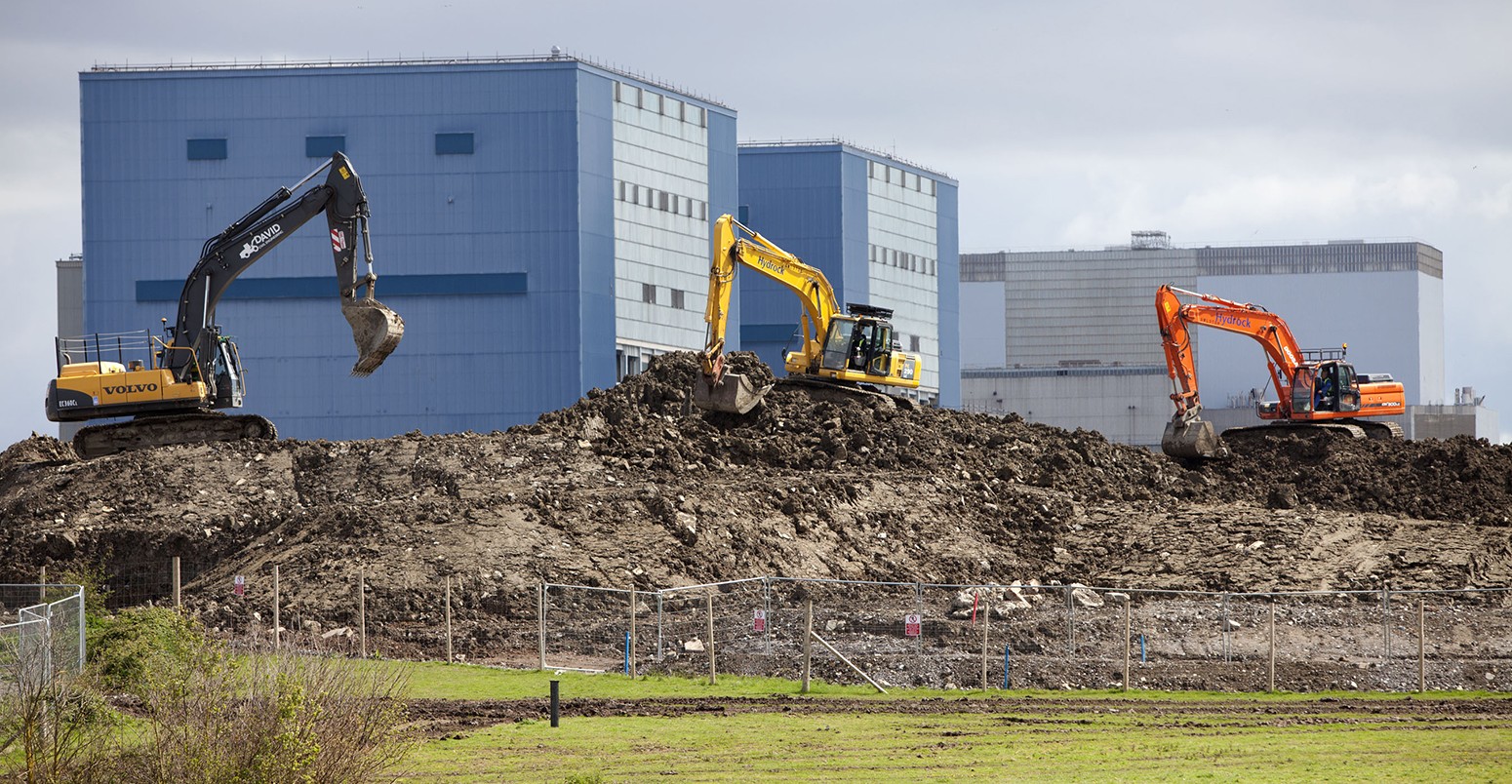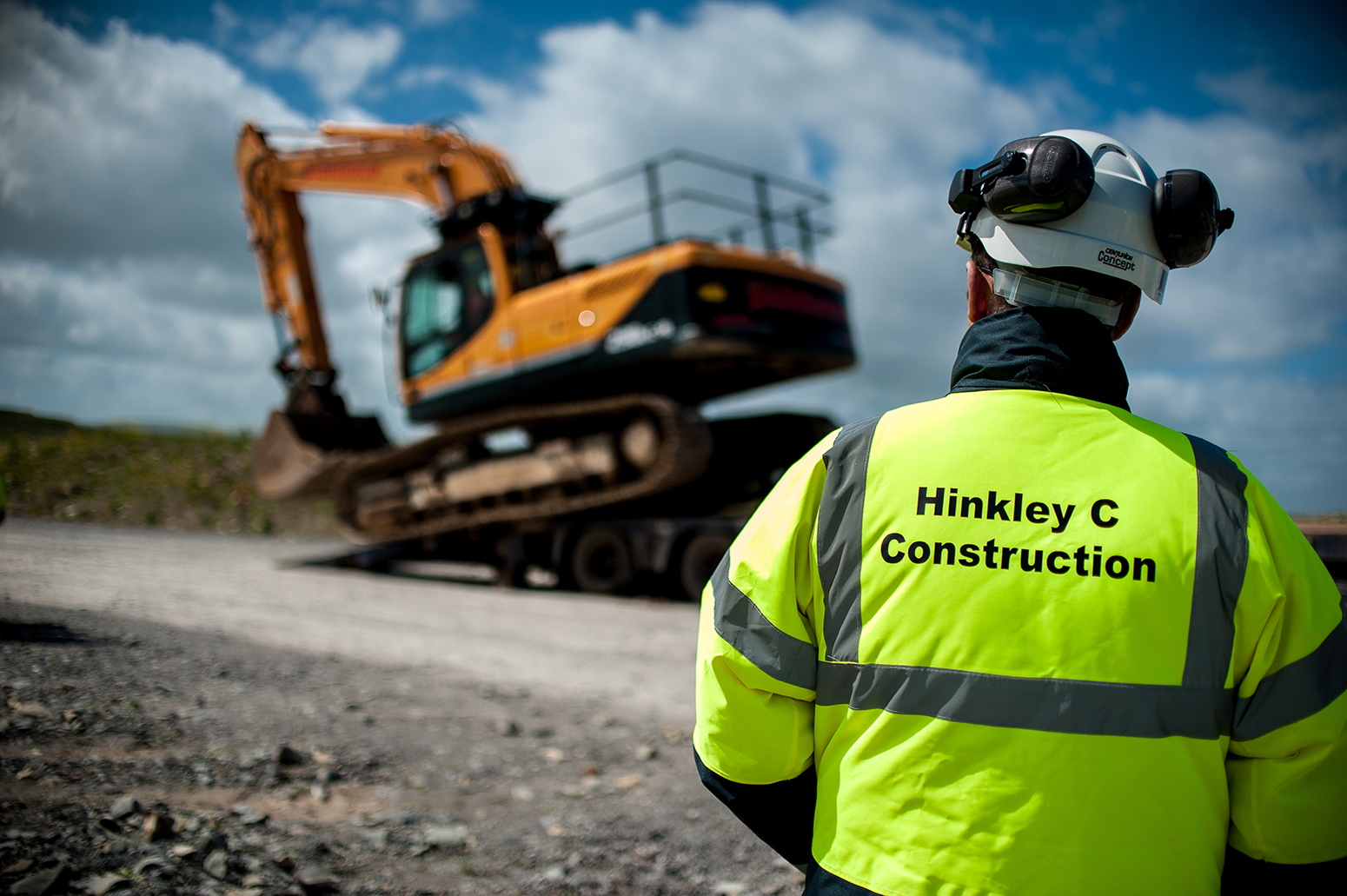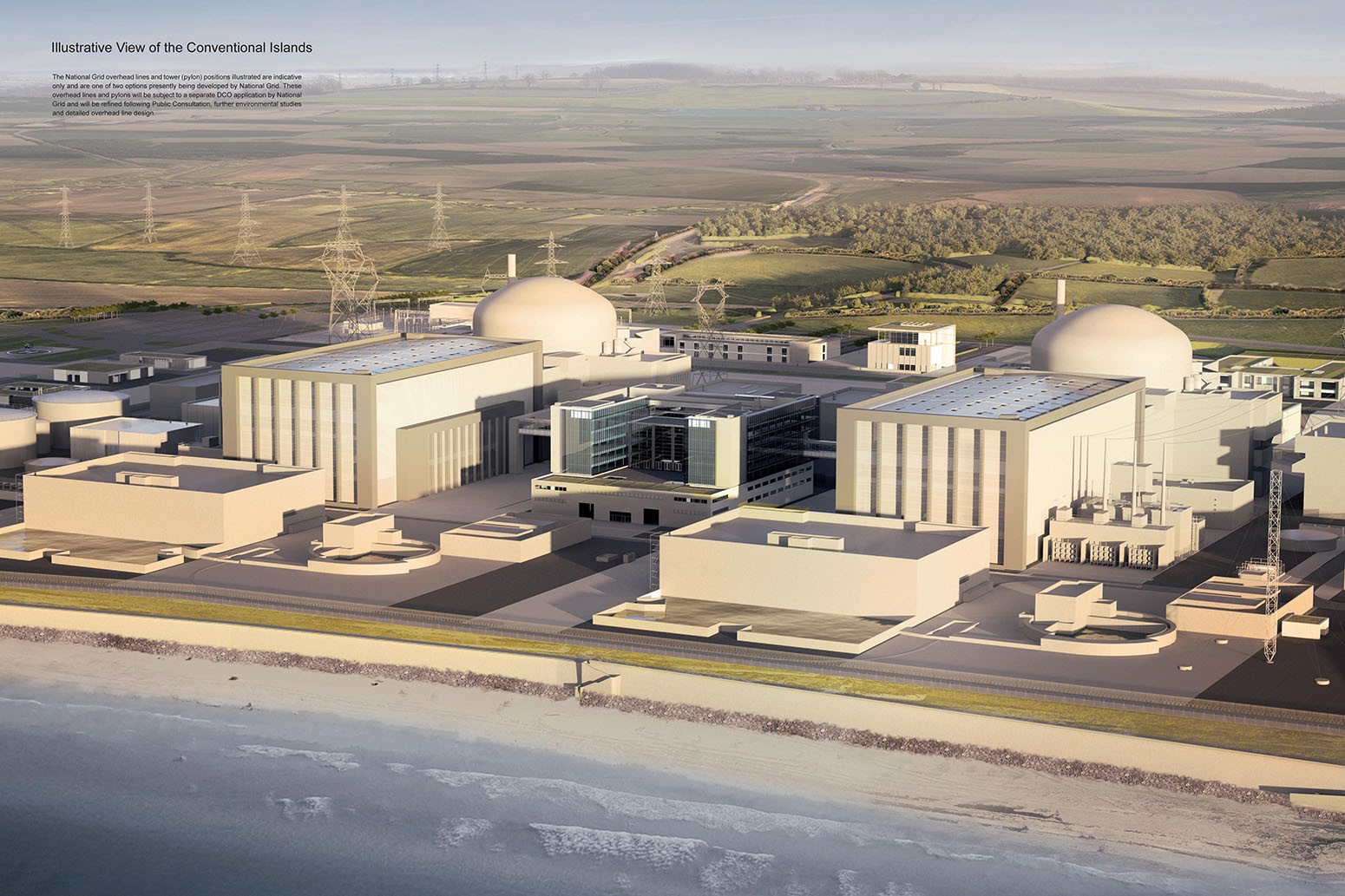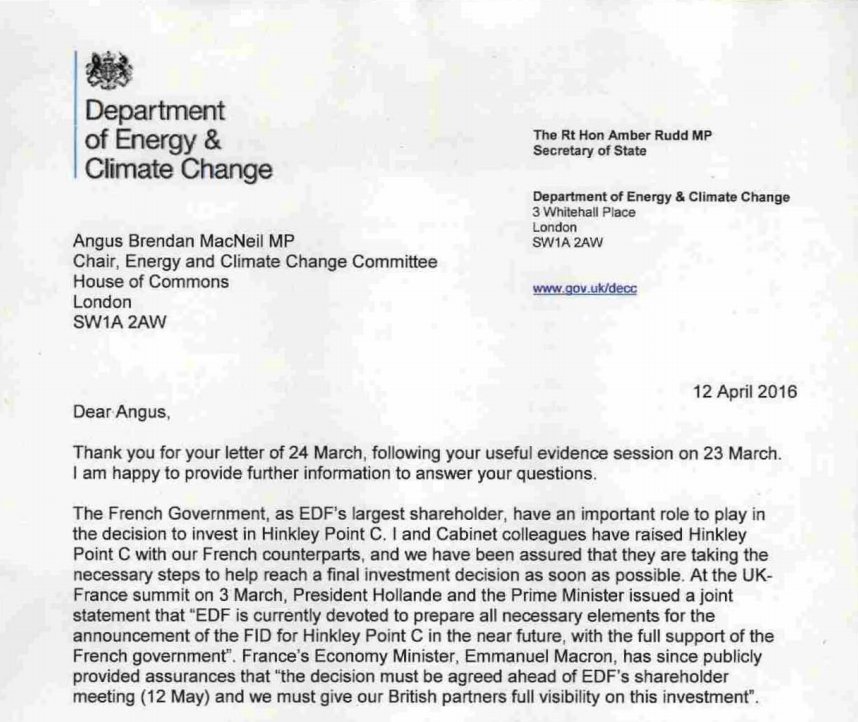
Update 15/9/2016 – The Department of Business, Energy and Industrial Strategy (BEIS) has given the go-ahead for the Hinkley C scheme. The move was welcomed by EDF and its Chinese partner CGN, as well as by various business, union and industry groups. A number of NGOs and thinktanks criticised the scheme.
On 28 July the board of French firm EDF voted 10-7 in favour of a final investment decision on the Hinkley C project in Somerset. It would be the UK’s first new nuclear plant in a generation.
The scheme, which has faced repeated delays, was swiftly thrown into fresh doubt just hours after EDF’s decision, when the UK government said it would make its own decision “in the early autumn”. It had been expected to sign contract terms on 29 July.
Carbon Brief runs through the key questions about the scheme, including how much it would cost, whether the UK can do without it and what happens if it is delayed.
What is Hinkley Point C?
Hinkley Point C is 3.2 gigawatt (GW) new nuclear plant due to be built near Bridgwater in Somerset, in southwest England. Extensive site preparation work has already taken place.
It is to be built next to the existing 1GW Hinkley Point B, which is due to be decommissioned in 2023, and Hinkley Point A, which was decommissioned in 2000.
Once built, the scheme would generate around 25 terawatt hours (TWh) of electricity each year. The output from Hinkley C is usually said to represent around 7% of UK demand for electricity. In fact, demand has fallen, and it is more than 8% of the 307TWh used in 2015.
Who is going to build it?
Energy firm EDF, which is 85% owned by the French government, will build the plant. It already runs the UK’s seven operating nuclear power plants.
China’s CGN has a 33.5% stake in the project. It is set to be joined by CNNC, another state-backed Chinese nuclear giant, according to the Telegraph, though the overall Chinese stake may not increase.
The two Chinese firms hope to build a Hualong One reactor at the site of the decommissioned Bradwell nuclear plant in Essex (see below).
In April 2016, then-energy minister Andrea Leadsom said that some 60% of the construction costs would be “placed with UK firms”. However, the reactor vessels will be built by Areva, the struggling French nuclear firm, which has agreed to sell its reactor business to EDF.
 Hinkley C Pre-Construction Works – May 2014. Credit: EDF.
Hinkley C Pre-Construction Works – May 2014. Credit: EDF.
What technology will it use?
Hinkley C will consist of two 1.6GW European Pressurised Reactors (EPRs), a so-called generation III+ advanced reactor design.
Four EPRs are already under construction, and all four are facing delays. Contracts were signed on the two-reactor Taishan scheme in China in 2007 and it was supposed to be completed in 2013. Construction began in 2009 and it is now set to start generating in 2017.
Olkiluoto in Finland is nine years behind schedule and three times over budget. It is expected to start generating in 2018, as is Flamanville in France. Originally due to finish in 2012, Flamanville faces extended safety tests over anomalies in its steel reactor vessel.
What has happened so far?
Hinkley C has a lengthy back-story. It was first floated in 2007, when EDF chief executive Vincent de Rivaz said power from Hinkley C could be cooking christmas turkeys by 2017. By 2008, local residents were being consulted. EDF made its planning application in 2012.
Flashback: How papers reported Labour’s decision in May 2007 to kickstart an era of new nuclear power #Hinkleypic.twitter.com/rwzf7Vjutp
— Leo Hickman (@LeoHickman) July 28, 2016
The EPR got safety approval in 2012 and EDF agreed subsidy terms with the government in October 2013. In October 2014, the European Commission gave state aid approval for the project. It was due to start generating in 2023, but has been delayed (see below).
The Telegraph has a detailed timeline on Hinkley C, starting with Labour’s 2005 energy review, which revived the idea of new nuclear in the UK.
How much will Hinkley C cost?
EDF has already spent £2.5bn on the project, reports Bloomberg, including £1bn for site preparation, according to Sky News. Construction is due to cost £18bn, EDF says, or £24.5bn if the cost of financing the project is included. (The National Audit Office says the use of private finance increased costs compared to government borrowing.)
The £18bn price tag is far higher than expected in 2008. It would make UK new nuclear the world’s most costly, according to a 2015 report from the Nuclear Energy Agency (NEA). It might even make Hinkley C the most costly object ever built, though not the costliest project.
How will Hinkley C be paid for?
The cost to bill-payers is less clear. EDF has agreed a 35-year contract for difference with the government. This means it will receive a guaranteed income of £92.50 per megawatt hour (MWh) of electricity that it generates. This is known as the “strike price”.
That figure is in 2012 prices and is index-linked to inflation, so it rises in line with prices. The strike price will fall to £89.50 if EDF also builds a new nuclear plant at Sizewell C.
At £92.50/MWh and an average output at 90% of maximum capacity, Hinkley C will earn £81bn over 35 years. This will be paid for by all electricity users. EDF only receives this income once the plant is generating power, so it must finance the cost of construction itself.
If the price of wholesale electricity is below £92.50/MWh, then part of the £81bn will be paid as a top-up subsidy.
The future price of wholesale electricity is unknowable. Spot prices currently hover around £35/MWh, according to data from consultants Aurora Energy Research, while government projections see that rising to £66 in 2030. Its public projections do not extend beyond 2035, even though the 35-year Hinkley C contract will run to 2060 or beyond.
At today’s wholesale price the top-up subsidy would amount to £50bn over 35 years, equivalent to £18 per household per year, Carbon Brief analysis shows. If prices averaged £66, the total top-up would fall to £24bn, or £9 per household per year.
The National Audit Office puts the cost of top-up subsidies at £30bn, reports the Guardian. Note that this is in 2015-16 prices, whereas the other figures in this article are in 2012 prices.
If the project is significantly more profitable than expected, the additional profits must be shared via reductions in the £92.50/MWh strike price. The contract also says that the strike price will be adjusted if the project is refinanced with cheaper debt.
Would other technologies be cheaper?
In July 2016, the National Audit Office said that onshore wind and solar would be far cheaper than new nuclear or gas in levelised cost terms. It says that other considerations might form a strategic case for new nuclear, citing renewables’ land requirements and intermittency.
The killer chart from NAO Hinkley C report. Wind/solar now seen as cheapest (<gas<<nuclear). https://t.co/4k7R8K4Nbupic.twitter.com/LNe8ybyUhS
— Simon Evans (@DrSimEvans) July 13, 2016
It’s worth noting that the cost of balancing intermittent wind or solar output is expected to be relatively low – perhaps £10/MWh, according to the Committee on Climate Change (CCC). Wind with backup would be no more costly than Hinkley, says Aurora Energy Research.
Onshore wind, solar and gas backup could supply as much consistent power as Hinkley C at 25% lower cost, says renewable developer Green Hedge. The Solar Trade Association says solar with storage and demand flexibility would need only half the Hinkley C subsidy.
There are five cheaper ways to replace Hinkley C, according to the Guardian, including increased energy efficiency. UK electricity demand has fallen by 46TWh over the past 10 years, equivalent to nearly two times Hinkley C’s expected output.
Even offshore wind could be cheaper than Hinkley C, according to Greenpeace Energydesk (projects came in at £117/MWh last year, but costs are falling).
 CGI view of Hinkley Point C. Credit: EDF.
CGI view of Hinkley Point C. Credit: EDF.
When will Hinkley C be built?
The timeline for Hinkley C has been pushed back several times (see above), from the initial promise of power in time for christmas 2017 to the 2023 date agreed when signing subsidy terms and later, a delay to 2025.
EDF now says the first concrete will be poured for reactor one in mid-2019. In March, it repeated that the first reactor would be operational by the end of 2025.
However, it has also given a 115-month schedule for the time between a final investment decision and first reactor commissioning. From July 2016, 115 months runs to January 2026. Remember also that the other four EPR projects have all been delayed.
What happens if it is delayed?
The full contract agreed between EDF and the government is not public. However, some details are available. If either of Hinkley C’s two reactors is more than four years late, the contract term for top-up subsidies will be reduced by one day for each day of delay.
In the proposed contract, the target start date is 2025 and the delay penalty kicks in from 2029. If the reactors are delayed by more than eight years, the contract can be cancelled.
Hinkley C: DECC targets 2025 start; CfD term will be reduced if >4yr delay; CfD could be cancelled for >8yr delay. https://t.co/Pv6Gfvk0vJ
— Simon Evans (@DrSimEvans) February 16, 2016
Any delays could have consequences for electricity supplies and carbon targets, see below.
What will it mean for emissions?
One of the primary selling points of Hinkley C is that it will generate electricity with near-zero carbon emissions. If that electricity were replaced by gas-fired generation, an extra 8-11 million tonnes of CO2 (MtCO2) would be emitted each year, Carbon Brief analysis shows.
As noted above, energy efficiency or other zero-carbon alternatives could replace Hinkley C, even if the numbers of wind- or solar farms required would be relatively large.
However, carbon accounting rules and the UK’s current membership of the EU Emissions Trading System (EU ETS) mean that – for now at least – increases in UK power sector CO2 emissions must be balanced by cuts elsewhere. See our January analysis for more details.
Could the UK do without Hinkley C?
Any delays to Hinkley C getting built raise two major questions for the UK. First, will electricity supplies remain sufficient to keep the lights on and second, can the UK still meet its carbon targets.
In answer to the first question, then-secretary of state Amber Rudd said “arrangements [were] in place” to deal with any delay or cancellation of Hinkley C. These include the capacity market, which pays a retainer to ensure electricity supplies can cover demand.
However, if delays emerged at short notice, the costs of keeping the lights on could increase, Rudd said. In answer to the second question, Rudd warned that delays at Hinkley C could put carbon targets at risk (see above).
One idea for a low-carbon Hinkley alternative was backed by an anonymous government minister in the Independent. It would link Norway and the UK via the Dogger Bank offshore windfarm, with Norwegian hydro providing low-carbon backup when the wind isn’t blowing.
Is Hinkley C now guaranteed?
In short, not even close. Shortly after EDF’s decision, Greg Clark, secretary of state for Business, Energy and Industrial Strategy said in a statement:
It is unclear what to read into the surprise delay.
Meanwhile the Austrian government is challenging the state aid approval given to Hinkley C subsidies, though UK ministers say the case does not have “any merit”.
Other potential stumbling blocks include a challenge to French government financial support for EDF, which could be blocked according to a legal opinion commissioned by Greenpeace.
EDF’s financial problems stem from high debt, falling power prices and an expected €55bn bill to extend the life of the French nuclear fleet. Areva, which will build the reactor vessels for Hinkley C, is also struggling and faces claims over the delayed Olkiluoto project.
Ratings agencies Moody’s and Standard and Poor’s have downgraded EDF debt, bringing it close to junk status. Both agencies have said they might downgrade EDF further, if the Hinkley scheme goes ahead.
EDF’s then-finance chief Thomas Piquemal quit the firm in March because he feared Hinkley C could jeopardise its financial position. French unions, which hold six seats on EDF’s 18-seat board, are also opposing Hinkley C.
How has the media reacted to the latest delay?
The UK government delay featured on the front pages of several UK newspapers including the Financial Times , Times and Guardian. A second Financial Times article reports: “Officials said Mrs May’s cautious approach lies behind the delay but [EDF] will now worry that the political consensus could soon break”.
A third Financial Times piece says the delay “marks [a] rethink on Chinese investment in [the] UK”. It notes fears from Nick Timothy, joint chief of staff to prime minister Theresa May, that China “could close down nuclear reactors in Britain as a form of energy blackmail”.
A BBC article by economics editor Kamal Ahmed suggests four options to explain why the decision was delayed, just days after chancellor Philip Hammond said the project “will go ahead”. It says the decision to hit the pause button was made at the last minute, and asks if the Sizewell C and Bradwell new nuclear projects will now be reassessed (see below).
Ahmed writes: “Reassurance is the word that is being used by my sources. Not cancellation – not yet anyway…My sources say that at this stage we should not over-interpret the review.”
There were also four newspaper editorials on the Hinkley project. The Guardian says approval would be “a disaster for British energy policy…it will displace billions of pounds of investment that could otherwise be spent reducing demand and developing renewable alternatives”.
The Times says “Alternatives…are now so numerous that the government should cut its losses and start again”. The Sun says Hinkley “looks like the priciest, least efficient solution to our energy problems”. The Daily Mail says there are “extraordinary risks” in the project.
Are other UK new nuclear plants planned?
Yes. Including Hinkley C, some 13 new nuclear reactors are planned in the UK across six sites from the mid-2020s onwards, with a combined capacity of 18GW. Note that EDF is supposed to build four of these reactors, at Hinkley and at Sizewell in Suffolk.
Timeline for UK’s various new nuclear plans, via NAO. NB uncertainty “possibly 2028” etc. https://t.co/4k7R8K4Nbupic.twitter.com/P5fkADSsz5
— Simon Evans (@DrSimEvans) July 13, 2016
NuGen is planning to build three AP1000 reactors at Moorside in Cumbria. It is a collaboration of Japanese technology firm Toshiba and French utility Engie. Hitachi, another Japanese firm, has formed Horizon to build four units at Wlyfa Newydd on Anglesey and Oldbury in Gloucestershire.
Finally, as noted above, China’s CGN and CNNC hope to build two Hualong One reactors at Bradwell in Essex.
Can the UK do without new nuclear?
The UK’s decarbonisation challenge goes well beyond Hinkley C. The UK must progressively replace large parts of its existing electricity generating capacity over the next two decades as it seeks to decarbonise the sector in line with its legally binding climate goals.
The latest CCC progress report (see pp 78-79) says government should “consider alternative strategies to replacing the existing nuclear fleet, without increasing carbon emissions”. In 2015, nuclear supplied 21% of UK electricity.
The CCC says alternatives for decarbonising without new nuclear include tidal lagoons, additional offshore wind, other renewables, carbon capture and storage (CCS).
A CCC scenario for 2030 that stays on track towards the UK’s 2050 carbon target without new nuclear, includes 15GW of new offshore wind in the 2020s and multiple gigawatts of power generation fitted with (CCS), as well as tidal lagoons.
However, a £1bn government scheme to commercialise CCS was cancelled last year. The government has commissioned a review of the cost-effectiveness of tidal lagoons. The UK has around 5GW of offshore wind capacity. It will support “up to 10GW” more in the 2020s.
The CCC has also estimated practical limits to onshore wind and solar, respectively around 80TWh and 140TWh, which can be compared to current UK demand of 307TWh. There is a much larger potential resource from offshore wind of more than 400TWh.
Critics of renewables point to the cost of balancing their intermittency. The CCC says while these costs are minimal, at around £10/MWh, they start to spiral upwards at high renewable deployment rates (around 50GW for wind or 40GW for solar).
Note that technology changes could ease these limits to renewable resource and intermittency costs.
Note also that while electricity demand has been falling for a decade, it is expected to rise in the medium term because of electrification of some heat and transport energy demand, using heat pumps and electric vehicles.
What about mini-nukes?
The government has launched a £250m competition for small modular reactors (SMRs). These small reactors of 300MW or below could overcome the Hinkley C problem of very high upfront capital costs.
It is hoped that costs could come down if many SMRs are produced on a production line, though this remains to be tested. Importantly, SMRs are unlikely to be a short-term solution.
In an interview with Carbon Brief, Tom Greatrex, chief executive of the Nuclear Industry Association, said “it will be a real push [for SMRs to be deployed] in the 2020s”.
Main image: Pre-construction work at Hinkley Point C site, with Hinkley Point B in the background – May ’12. Credit: EDF.
-
The UK is set to get its first new nuclear plant in a generation, Hinkley Point C


